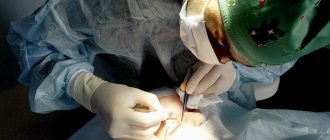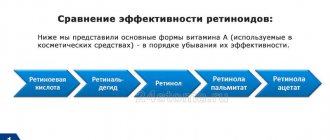Partial circumcision of the foreskin - what is it?
Partial circumcision, more accurately called “incomplete circumcision,” is a surgical procedure in which only part of the foreskin (prepuce) of the penis is removed, leaving the head of the penis partially covered.
If complete circumcision is performed primarily in accordance with the cultural and religious traditions of a man and is much less often performed for medical reasons, then incomplete circumcision is a purely medical procedure, that is, not in any way related to culture or religion.
Why circumcision in men?
First of all, circumcision is a surgical procedure. There are a number of reasons that push the male sex to undergo circumcision (circumcision), among them:
- Medical indications . In each specific case, doctors convince male patients that circumcision is necessary. This happens because the foreskin is often injured and serves as a site for the accumulation of all kinds of infections, which often lead to problems of the genitourinary system and even cause cancer.
- Religious motives . Circumcision in some countries is a cultural-historical part and part of the religion, which was reinforced by centuries-old practice. To this day, such canons are strictly adhered to by Muslims and Jews, and the procedure itself is carried out in infancy, to which parents give their consent.
- Aesthetics . Some men, in order to demonstrate the beauty and advantage of their penis, undergo such an operation already in adulthood. This step is only cosmetic in nature.
- Sexual beliefs . Some couples believe that the circumcision procedure can make its own pleasant adjustments to their sex life. Some scientific studies have proven that women get more pleasure with a circumcised partner, and the act itself lasts many times longer.
Indications for incomplete circumcision
The main indication for partial circumcision is phimosis (narrowness of the foreskin, making it difficult to freely expose the head of the penis), while the patient does not want to completely remove the prepuce. In this case, if the phimosis is localized on the upper or middle part of the foreskin, the doctor can excise only that area of the prepuce that directly prevents the free exposure of the head of the penis.
Other indications for incomplete circumcision include:
- hypertrophic (proboscis) phimosis - excessive growth of the foreskin, when exposure of the head of the penis does not occur even with a full erection;
- polyps or condylomas on the foreskin;
- chronic balanoposthitis - inflammation of the inner part of the prepuce;
- trauma - if it is impossible to restore the foreskin.
Disadvantages of male circumcision
The disadvantages include:
- Painful shock caused in infants in cases where anesthesia is not used. In the last decade, at the insistence of parents, the procedure for young children is performed using local anesthesia.
- Hygiene after the operation should be more thorough with constant care of the head and folds.
- Risk of contracting infections immediately after cutting off the flesh. To a large extent, the positive outcome of surgery depends on the competence of the operating doctor. If mistakes are made during the process, the most disastrous consequences can arise, including amputation of the organ.
- Risk of permanent injury to the penis.
- After the operation, the head of the penis remains dry.
- Pain when the head of the penis rubs against underwear.
- Lack of sensation during sexual intercourse.
Types of partial circumcision
Based on the nature of the procedure, the incomplete circumcision procedure can be divided into two types:
- High cut.
A small part of the foreskin is removed, as a result of which the head of the penis is exposed to a maximum of the middle.
- Low cut.
The foreskin is removed along the coronal groove of the penis.
The issue of preserving or removing the frenulum during partial circumcision is decided individually based on the reasons for which the operation is performed.
Muslim male circumcision
Male circumcision is considered one of the oldest religious rites in Islam. It is curious that this ritual is not mentioned in the Holy Book of Muslims, but in the legends it is not only described, but also reminds of the need for this procedure.
Traditions that tell about the prophet Ibrahim, who circumcised himself at the age of 80, call for Muslims to treat this ritual with full responsibility. However, there are other legends that say that cutting off is not a mandatory rite and is done solely at will.
Islamic theologians who give recommendations for conducting the procession interpret it based on the legends of Bayhaki. They say that the Prophet Muhammad circumcised his grandchildren on the 7th day of their life. Theologians and doctors say that circumcision should be done as early as possible, since the reason for such a procession needs to be explained to an older child and psychological trauma can be caused. However, circumcision in infancy carries great dangers. This is why Muslims living in different countries circumcise children at different ages. Do not forget that, despite the strictness of the canons, the opinion of the parents is also taken into account before the procedure is carried out. After the operation, the head of the family throws a feast and invites all relatives to tell about their joy.
How is incomplete circumcision performed?
Partial circumcision is performed under local or general anesthesia using a surgical scalpel or laser. The operation itself is performed as follows:
- The foreskin is fixed and stretched. Sometimes, for the convenience of the surgeon, the penis is placed in a state of artificial erection.
- The prepuce is excised in a circle to the required extent.
- Sutures made of self-absorbing materials are placed at the incision site, and an antiseptic bandage is placed over the sutures.
In general, the incomplete circumcision operation lasts no longer than half an hour. Complete hospitalization after partial circumcision is not required; after 2-4 hours the patient can freely leave the medical facility.
Features of rehabilitation after partial circumcision
Complete healing of the circumcised foreskin occurs within 1-4 weeks, depending on the general physical condition of the patient and the method of surgery. During this period, the patient is prohibited from:
- have sexual intercourse or masturbate;
- engage in active sports;
- visit the pool, bathhouse or sauna.
To relieve postoperative pain, patients are prescribed a general pain reliever - analgin, ketanov, etc. Dressings and scar care are performed using those antiseptic and/or antibacterial agents prescribed by the attending physician. It is also recommended to gently wash the penis with warm water after each urination.
Possible complications
Complications that may occur after circumcision of the foreskin include:
- Bleeding. During the first 2-3 days, slight bleeding is normal. To stop the bleeding, you need to apply pressure to the bleeding area with a sterile cloth or bandage for 5-10 minutes.
- Suppuration. Occurs when the postoperative scar is not properly cared for and requires the intervention of a urological surgeon.
- Swelling. Can last up to 2-3 weeks. An alarming sign is increased swelling with the addition of severe pain.
- Peeling of the head of the penis. A variation of the normal reaction of the scalp to the removal of protection in the form of the prepuce. The crusts that appear during the peeling process can be soaked with chlorhexidine.
- Lumps under the foreskin. Usually we are talking about thrombosed vessels, which spontaneously resolve within a month.
- Difficulty urinating. Often caused by a psychological fear of urinating immediately after surgery, which disappears within 1-2 days, but in the presence of pain it can be a sign of an inflammatory process.
If the listed complications do not disappear over the specified period of time, the patient should see his doctor.
How is male circumcision done?
During this process, the foreskin is cut off along its entire circumference using local anesthesia, and in some situations, anesthesia. In advanced countries, the procedure includes the use of various clamps, which are selected for the size of each penis separately and prevent cuts to the head of the penis. After completion of the surgical intervention, stitches are applied, and in some situations, clamps are used, which are removed after the wound has completely healed.
In Russia, “manual technology” is used. The doctor cuts away the flesh and sews the edges together with absorbable suture material. Modern laser technologies are also used. This method allows you to significantly reduce risks and make an accurate cut. The laser method of cutting off flesh has a minimal recovery period. Laser surgery is completely sterile and does not require the application of special tourniquets or bandages.
Basic questions about partial circumcision
1. Will penis size change after circumcision?
No, the size of the penis will not change in any way, although visually, due to the absence of the foreskin, the penis may be subjectively perceived by a man (or his sexual partner) as having increased or decreased.
2. Does your sex life suffer after partial circumcision?
In general, no. However, in the first 1-2 months, men do notice a certain discomfort, which is explained by the unfamiliarity of having sex with a partial absence of the prepuce. As you get used to it, your sex life will become completely normal.
3. Is it true that with partial circumcision it takes longer to get used to the friction of the head?
This is quite subjective, but generally speaking, getting used to the friction may actually take a little longer than with complete circumcision. The reason for this is the incomplete opening of the head of the penis, as a result of which only a small part of it is exposed to friction, which slows down the process of addiction.
Pros and cons ↑
There are some benefits to penis circumcision, as discussed above.
Firstly, this is an opportunity to prevent the occurrence of any malignant tumors in the future. Of course, male circumcision does not prove the absence of disease, but there is undeniable evidence that many diseases come from penile cancer.
Secondly, circumcision is an excellent effective remedy against AIDS and many other diseases that are transmitted to us through the sexual tract. Of course, after circumcision there is a chance of getting sick, but it is very small.
Thirdly, this is an increase in the duration of sexual intercourse. Yes, yes, penis circumcision has very pleasant advantages. The duration is explained by the fact that circumcision in men increases the sensitivity of the glans, and this directly affects the duration of your sexual intercourse.
But, like the advantages, circumcision also has several disadvantages:
Firstly, circumcision in men itself is accompanied by a short duration. But it is a very excruciating pain, although in infants circumcision only causes shock.
Secondly, this is careful hygiene of the male genital organs. After circumcision has been completed, the male genital organ requires careful care. In particular, after circumcision, it is necessary to maintain hygiene of the glans, since pathogenic microorganisms can appear in the recesses of the folds. So after circumcision, you should carefully monitor the genitals.
Thirdly, there is the risk of various infections after circumcision has been completed. Of course, this point most of all depends on how well the male circumcision was performed, as well as on how much circumcision costs.











